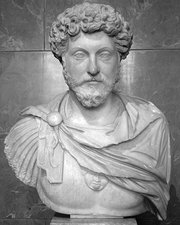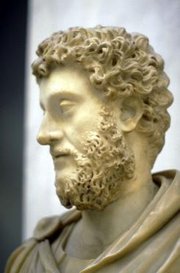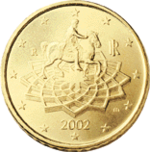Marcus Aurelius
|
|
Imperator Caesar Marcus Aurelius Antoninus Augustus (April 26, 121 – March 17, 180) was Roman Emperor from 161 to his death in 180. He was born Marcus Annius Catilius Severus, and at marriage took the name Marcus Annius Verus. When he was named Emperor, he was given the name Marcus Aurelius Antoninus; "Aurelius" means "golden."
| Contents |
Biography
His uncle Antoninus Pius adopted him as a son and designated him his successor on February 25, 138, when Marcus was only seventeen years of age. Antoninus also named Lucius Verus as his successor. When Antoninus died on March 7, 161, Marcus accepted the throne on the condition that he and Verus were made joint emperors (Augusti), with Verus partly subordinate. The reasons for this are unclear but are thought to have been part of the succession arrangement of Antonius's predecessor, Hadrian. After the death of his first adopted son, Aelius Verus, Hadrian appointed Antoninus Pius his successor on the condition that Antonius in turn would adopt Marcus Annius Verus, the son of his wife's brother, and Lucius, son of Aelius Verus, and arrange for them to be next in line. In time they became the emperors Marcus Aurelius and Lucius Aelius Verus.
The joint succession may have been motivated by military exigency. During his reign Marcus Aurelius was almost constantly at war with various peoples outside the Empire. Germanic and other peoples launched many raids along the long European border, particularly into Gaul. (They, in turn, may have been under attack from more warlike tribes farther east.) In Asia, a revitalized Parthian empire renewed its assault. A highly authoritative figure was needed to command the troops, yet the emperor himself could not defend both fronts at the same time. Neither could he simply appoint a general to lead one assault; earlier popular military leaders like Julius Caesar and Vespasian had used the military to overthrow the existing government and install themselves as supreme leaders.
Marcus Aurelius solved the problem by sending Verus to command the legions in the east. He was authoritative enough to command the full loyalty of the troops, but already powerful enough that he had little incentive to overthrow Marcus. The plan was successful - Verus remained loyal until his death on campaign in 169. This joint emperorship was faintly reminiscent of the political system of the Roman Republic, which functioned according to the principle of collegiality and did not allow a single person to hold supreme power. Joint rule was revived by Diocletian's establishment of the Tetrarchy in the late 3rd century.
Aurelius married Faustina the Younger in 145. During their 30-year marriage Faustina bore 13 children, most notably son Commodus who would become Emperor and daughter Lucilla who was wed to Lucius Verus to solidify his alliance with Marcus Aurelius.
While on campaign between 170 and 180, Aurelius wrote his Meditations as a source for his own guidance and self-improvement. His notes were representative of Stoic philosophy and spirituality. These meditations survive and are studied by others to this day.
Marcus Aurelius died on March 17, 180 during the expedition against the Marcomanni in the city of Vindobona (modern Vienna). His ashes were returned to Rome and rest in Hadrian's mausoleum. He was able to secure the succession for his son Commodus, whom he made co-emperor in his own lifetime (in 177), though the choice may have been unfortunate. Commodus was a political and military outsider, as well as an extreme egotist. Many historians believe that the decline of Rome began under Commodus. For this reason, Aurelius' death is often held to have been the end of the Pax Romana.
Contacts with China
The first of several Roman embassies to China, although attributed to Antoninus Pius by the Hou Hanshu (History of the Later Han Chinese dynasty), was probably sent out by Marcus Aurelius. Antoninus Pius died in AD 161, while the convoy arrived in AD 166. The confusion arises because Marcus Aurelius took as additional names those of his predecessor, as a mark of respect. The emperor is referred to in Chinese history as "An Tun" (= Antoninus). The mission reached the Chinese capital Luoyang in 166 and was greeted by Emperor Huan of the Han Dynasty.
Depictions in art
A well preserved bronze equestrian sculpture of Marcus Aurelius, which during the Middle Ages had stood in the Lateran Palace in Rome, was relocated in 1538 to the Piazza del Campidoglio (Capitoline Hill); currently the original is inside the Musei Capitolini, while a copy is on display in the square. It is the only surviving bronze statue of a pre-Christian Roman emperor — the reason being that following Rome's conversion to Christianity, when statues of Emperors were being melted down to make statues for the Christian churches, it was (incorrectly) thought that the statue was of the Emperor Constantine, who 'christianised' Rome, and so it was left untouched. According to accounts from medieval times, a small figure of a bound barbarian chieftain once crouched underneath the horse's front right leg. In addition, it was one of the few Roman statues to remain on public view during the Middle Ages. Such an image was meant to portray the emperor as an always victorious all-conquering lord of the earth. However, shown without weapons or armor, Marcus Aurelius seems to be a bringer of peace rather than a military hero, for this is how he saw himself and his reign. This statue is the subject of a €0.50 Italian euro coin designed by Roberto Mauri.
Appearances in film and literature
- The Fall of the Roman Empire (1964 film), played by Alec Guinness
- in Memoires d'Hadrien (1951), a ficticious but plausible auto-biography -in french- of one of his predecessors, Hadrian, by Marguerite Yourcenar (acclaimed master work of this female member of the Académie française)
- Household Gods (1999 novel), by Judith Tarr and Harry Turtledove. ISBN 0613351479.
- Gladiator (2000 film), played by Richard Harris
See also
- Roman Empire
- List of Roman Emperors
- the Five Good Emperors, of which Marcus Aurelius is considered the last
External links
Primary sources
- The Meditations (http://onlinebooks.library.upenn.edu/webbin/book/search?author=Marcus%20Aurelius)
- Historia Augusta: Life of Marcus Aurelius (http://penelope.uchicago.edu/Thayer/E/Roman/Texts/Historia_Augusta/Marcus_Aurelius/1*.html)
Secondary material
- Marcus Aurelius (http://www.roman-emperors.org/marcaur.htm) entry at De Imperatoribus Romanis
- Pictures and selected quotes (http://www.onelittleangel.com/wisdom/quotes/marcus_aurelius.asp)




